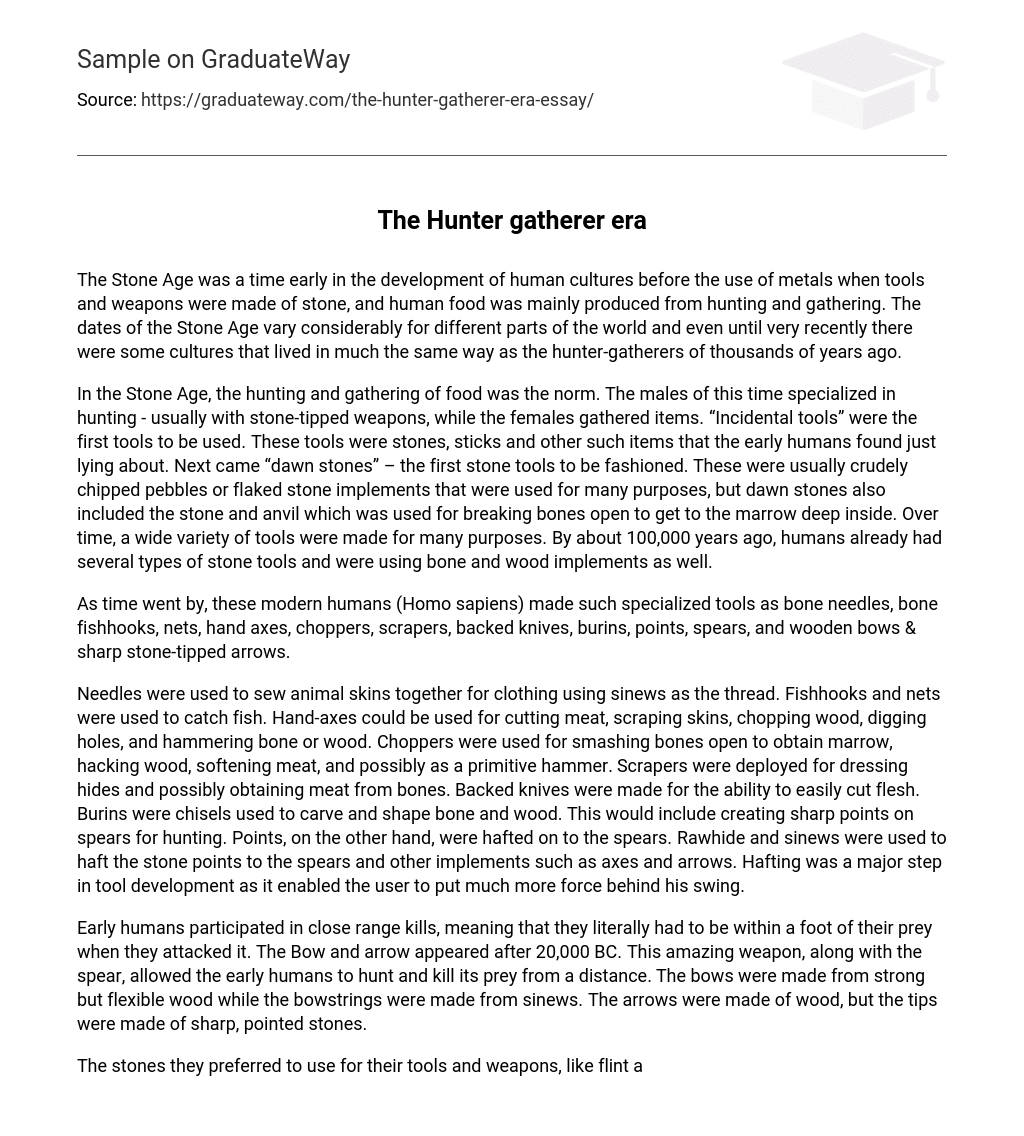The Stone Age, characterized by the utilization of stone tools and weapons, was a time when humans relied on hunting and gathering as their means of survival. The length of this period varied across different regions, with certain societies persisting as hunter-gatherers until more recent times.
In the Stone Age, food was obtained by hunting and gathering. Men primarily focused on hunting using stone-tipped weapons, while women gathered various items. The earliest tools were “incidental tools” like stones and sticks that were easily found. Afterwards, “dawn stones” emerged as the first crafted stone tools, including roughly chipped pebbles and flaked stone implements used for various tasks. Dawn stones also included the stone and anvil, a tool used for breaking bones to access marrow. Over time, a variety of tools were created for different purposes. Approximately 100,000 years ago, humans had developed multiple types of stone tools and also utilized bone and wood implements.
Over time, Homo sapiens developed various specialized tools, such as bone needles, bone fishhooks, nets, hand axes, choppers, scrapers, backed knives, burins, points, spears, and wooden bows & sharp stone-tipped arrows.
The use of needles with sinews as thread was employed for sewing animal skins together to make clothing. Fishing was done using fishhooks and nets to catch fish. Hand-axes were versatile tools that had various uses such as cutting meat, scraping skins, chopping wood, digging holes, and hammering bone or wood. Choppers were used to break open bones to extract marrow, hack wood, tenderize meat, and potentially function as a primitive hammer. Scrapers were utilized for dressing hides and potentially extracting meat from bones. Backed knives were crafted specifically for easily cutting flesh. Burins served as chisels for carving and shaping bone and wood, including the creation of sharp points on spears for hunting. Points would then be attached to the spears using hafting, which involved using rawhide and sinews to secure stone points to implements like axes and arrows. Hafting was a significant advancement in tool development as it allowed the user to exert more force with their swing.
Early humans engaged in close range kills where they had to be physically within a foot of their prey to attack. The Bow and arrow emerged after 20,000 BC and provided these early humans with the capability to hunt and kill from a distance, alongside the spear. The bows were crafted using sturdy yet flexible wood, while the bowstrings were created using sinews. The arrows were primarily composed of wood, but their tips consisted of sharp and pointed stones.
The stones that they favored for their tools and weapons, such as flint and obsidian, possessed exceptional hardness. Such stones could be fractured with a bone or antler, resulting in flakes resembling a human fingernail. During this procedure, carefully removing chips from the upper and lateral surfaces produced a refined stone core. From this core, complete flakes were subsequently extracted and honed into various specialized tools. The flaked edges exhibited a surface thickness equivalent to a single molecule, surpassing the sharpness of a razor blade.
During the Neolithic period, also known as the New Stone Age, stone tools were polished and diverse. The Aztecs and other Stone Age cultures excelled in tool making, creating highly decorative and visually appealing ceremonial cutting objects with functional form and symmetry. It is likely that these elaborate tools were employed in religious ceremonies.
Besides game caught from hunting, hunter-gatherers would also consume a diverse range of wild-grown seeds, berries, fruits, roots, nuts, and vegetables. Primarily, gatherers in early human societies were females and young children. These individuals would collect plants, fungi, and small animals not only for food but also for medicinal purposes, textiles, and various other uses.
The early humans foraged for a wide range of food, comprising bulbs such as Indian potatoes, Jerusalem artichokes, wild leek, spring beauty, and wild onions. They also enjoyed various roots like carrots and beets, along with leafy green plants including asparagus, poke weed, cattails, and garlic leaves. Their diet included fruits like strawberries, grapes, apples, and cranberries. To preserve these fruits, they would press and dry them on rocks. Nuts like beechnuts, walnuts, hickory nuts, chestnuts,and acorns were also part of their diet. Furthermore,wild rice held significant importance among the variety of seeds they consumed.Additionally small animals such as fish,mollusks ,snails,and grubs were incorporated in their meals.
The gathering of various items had multiple purposes, including medicine. A specific example would be the willows, which contained a natural form of aspirin. Thules, pin oak, long grasses, and pine needles were also gathered and used for weaving baskets. Animal skins that were gathered were treated and utilized for clothing, while countless other collected items had uncountable alternative uses.
During the Stone Age, humans relied on hunting and gathering to survive. They made use of tools crafted from stone, wood, and bone to enhance their hunting abilities and improve their chances of survival. However, around 4,000 BC, the Stone Age came to a close as agriculture and animal domestication started gaining prominence.





